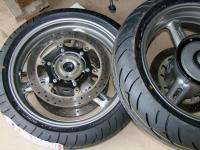Whether or not you use beads, the inside of the tire should be kept as dry as possible - minimize the amount of slime used to install tires. If there is sufficient humidity such that the partial pressure due to water vapor is significant, condensation (or evaporation) as a function of ambient temperature change will make tire pressure stability very poor. This is, perhaps, the only value in using nitrogen to fill tires - it is dry and non-condensing. Dry air is just as good (flame suit on).
As far as beads are concerned, free moisture will cause clumping as will gooey tire snot. I am skeptical that they are an effective means of balancing a tire but I guarantee that if they are wet and stuck, you would be better off without any balancing. FWIW, I find most MC tires are pretty good when new and that I don't really notice excessive vibration unless balance is off by a half ounce or more.




